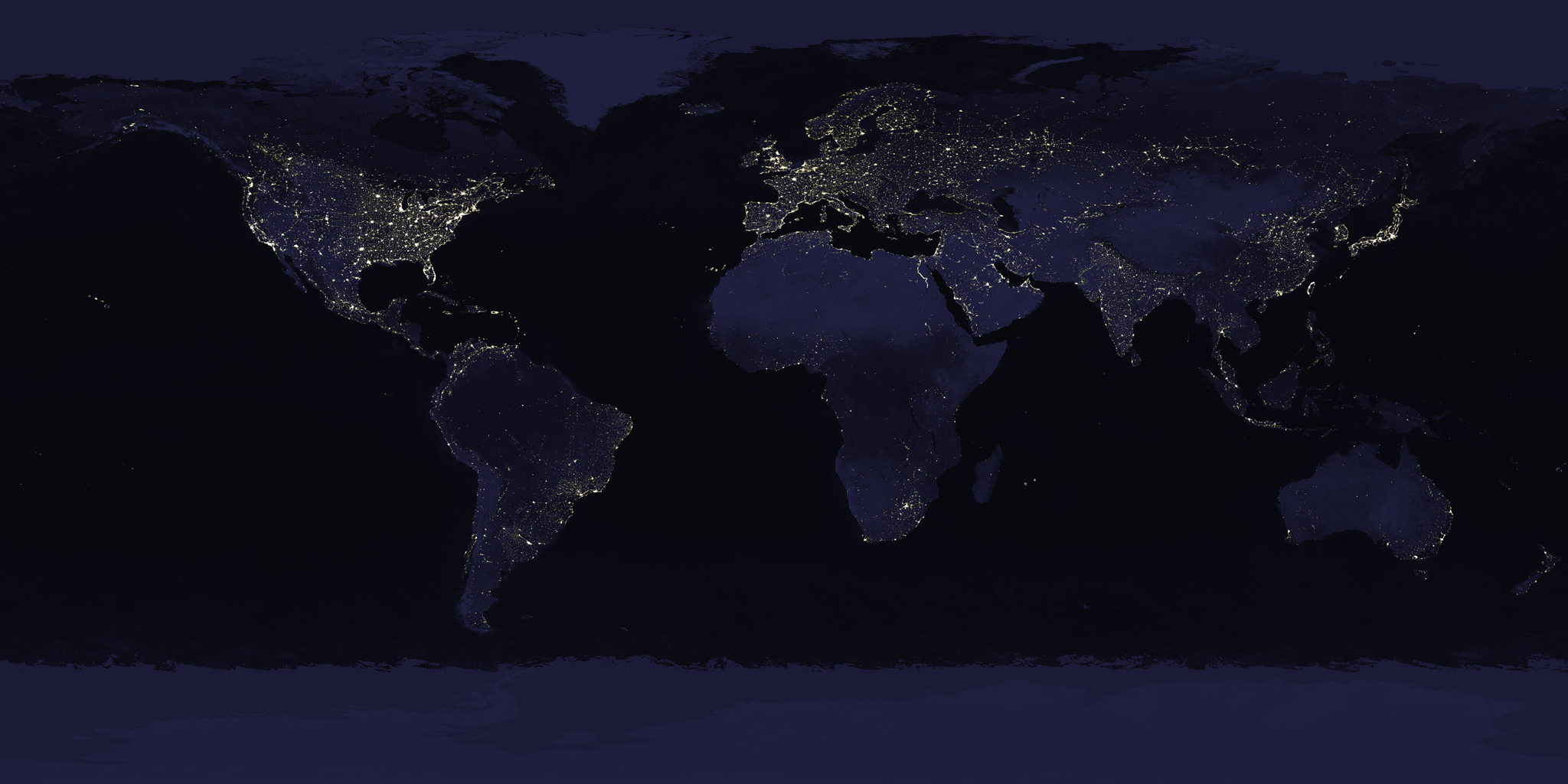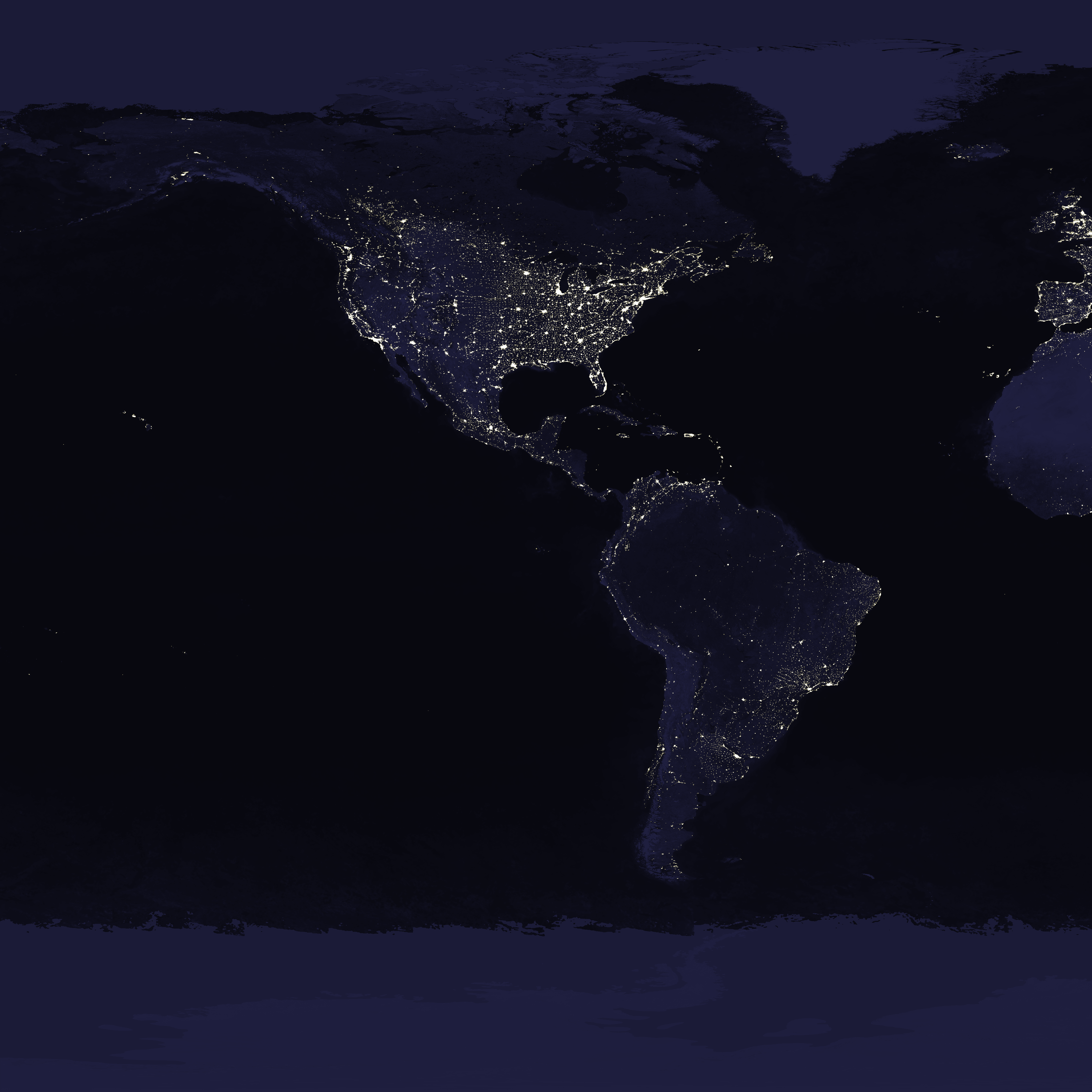Earth
ID: 2916
This image of Earth's city lights was created with data from the Defense Meteorological Satellite Program (DMSP) Operational Linescan System (OLS). Originally designed to view clouds by moonlight, the OLS is also used to map the locations of permanent lights on the Earth's surface.
The brightest areas of the Earth are the most urbanized, but not necessarily the most populated. (Compare western Europe with China and India.) Cities tend to grow along coastlines and transportation networks. Even without the underlying map, the outlines of many continents would still be visible. The United States interstate highway system appears as a lattice connecting the brighter dots of city centers. In Russia, the Trans-Siberian railroad is a thin line stretching from Moscow through the center of Asia to Vladivostok. The Nile River, from the Aswan Dam to the Mediterranean Sea, is another bright thread through an otherwise dark region.
Even more than 100 years after the invention of the electric light, some regions remain thinly populated and unlit. Antarctica is entirely dark. The interior jungles of Africa and South America are mostly dark, but lights are beginning to appear there. Deserts in Africa, Arabia, Australia, Mongolia, and the United States are poorly lit as well (except along the coast), along with the boreal forests of Canada and Russia, and the great mountains of the Himalaya.



Earth At Night (WMS)
The brightest areas of the Earth are the most urbanized, but not necessarily the most populated. (Compare western Europe with China and India.) Cities tend to grow along coastlines and transportation networks. Even without the underlying map, the outlines of many continents would still be visible. The United States interstate highway system appears as a lattice connecting the brighter dots of city centers. In Russia, the Trans-Siberian railroad is a thin line stretching from Moscow through the center of Asia to Vladivostok. The Nile River, from the Aswan Dam to the Mediterranean Sea, is another bright thread through an otherwise dark region.
Even more than 100 years after the invention of the electric light, some regions remain thinly populated and unlit. Antarctica is entirely dark. The interior jungles of Africa and South America are mostly dark, but lights are beginning to appear there. Deserts in Africa, Arabia, Australia, Mongolia, and the United States are poorly lit as well (except along the coast), along with the boreal forests of Canada and Russia, and the great mountains of the Himalaya.



Visualization Credits
Craig Mayhew (Raytheon): Lead Animator
Robert Simmon (SSAI): Animator
Christopher Elvidge (NOAA/NGDC): Scientist
Marc Imhoff (NASA/GSFC): Scientist
Robert Simmon (SSAI): Animator
Christopher Elvidge (NOAA/NGDC): Scientist
Marc Imhoff (NASA/GSFC): Scientist
Please give credit for this item to:
: data courtesy Marc Imhoff (NASA/GSFC) and Christopher Elvidge (NOAA/NGDC). Image by Craig Mayhew (NASA/GSFC) and Robert Simmon (NASA/GSFC).
: data courtesy Marc Imhoff (NASA/GSFC) and Christopher Elvidge (NOAA/NGDC). Image by Craig Mayhew (NASA/GSFC) and Robert Simmon (NASA/GSFC).
Short URL to share this page:
https://svs.gsfc.nasa.gov/2916
Data Used:
Note: While we identify the data sets used in these visualizations, we do not store any further details nor the data sets themselves on our site.
This item is part of this series:
WMS
Keywords:
DLESE >> Human geography
SVS >> Lights
GCMD >> Earth Science >> Human Dimensions >> Environmental Impacts >> Urbanization
GCMD >> Earth Science >> Human Dimensions >> Population >> Population Distribution
SVS >> For Educators
SVS >> World Map >> Night
SVS >> World Map >> Electricity
NASA Science >> Earth
GCMD keywords can be found on the Internet with the following citation: Olsen, L.M., G. Major, K. Shein, J. Scialdone, S. Ritz, T. Stevens, M. Morahan, A. Aleman, R. Vogel, S. Leicester, H. Weir, M. Meaux, S. Grebas, C.Solomon, M. Holland, T. Northcutt, R. A. Restrepo, R. Bilodeau, 2013. NASA/Global Change Master Directory (GCMD) Earth Science Keywords. Version 8.0.0.0.0
https://svs.gsfc.nasa.gov/2916
Data Used:
DMSP/OLS
Defense Meteorological Satellite Program Operational Linescan System
This item is part of this series:
WMS
Keywords:
DLESE >> Human geography
SVS >> Lights
GCMD >> Earth Science >> Human Dimensions >> Environmental Impacts >> Urbanization
GCMD >> Earth Science >> Human Dimensions >> Population >> Population Distribution
SVS >> For Educators
SVS >> World Map >> Night
SVS >> World Map >> Electricity
NASA Science >> Earth
GCMD keywords can be found on the Internet with the following citation: Olsen, L.M., G. Major, K. Shein, J. Scialdone, S. Ritz, T. Stevens, M. Morahan, A. Aleman, R. Vogel, S. Leicester, H. Weir, M. Meaux, S. Grebas, C.Solomon, M. Holland, T. Northcutt, R. A. Restrepo, R. Bilodeau, 2013. NASA/Global Change Master Directory (GCMD) Earth Science Keywords. Version 8.0.0.0.0











